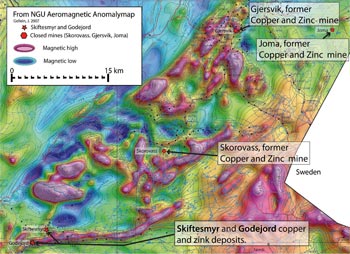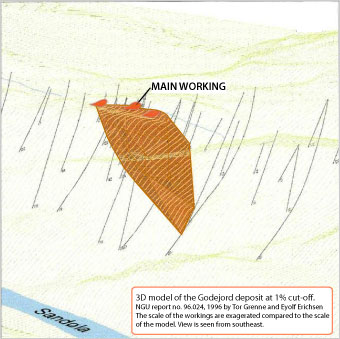
Godejord geology
Skiftesmyr’s and Godejord’s relationship to a large magnetic anomaly

Godejord lies within the Limingen Group south of the Gjersvik Group. The area is composed of greenstones, mica schist, amphibolites, felsic tuffs, phyllites and quartzites that have undergone Lower Amphibolite facies metamorphism. The area is mostly covered by overburden and swamps and few outcrops, except for old workings, exists near the mineralization. The rocks have undergone intense deformation and the general foliation strikes E-W with a 60-70° dip towards north.
A simplified sequence over the main mineralization consists of three geological units. The base is composed of massive mafic flows and dykes (greenstones). Stratigraphically above this unit an altered quartz-sericite and quartz-albite rich rock occurs, which hosts the main mineralization. This altered rocks also contains varying amounts of epidote, carbonates and calc-silicates (tremolite-actinolite mainly). The hanging wall is composed of a quartzite (exhalite) with ± magnetite ± sulphides ± pink garnet. Increased concentration of the magnetite forms a Banded Iron Formation (BIF) which can be traced for many kilometres both towards east and west. There are some rare sulphides associated with the main mineralization: mawsonite, mckinstryite, stromeyerite and one unnamed silver-copper-tellurium sulphide1, 2).
Historical resources and reserves
(note: The information below is based on a historical resource and mine plan from Braddick Resources Ltd’s pre-feasibility study in 1996 and are not up to NI 43-101 standards)
Godejord was mapped in the 1970’s, 1980’s and 1990’s. Geophysical methods, geochemical sampling and drilling were used by Grong Gruber, Norsulfid, Nord-Trøndelag county/NGU, and the Norwegian Geologiske Tjenester. All together 48 holes, with a total length of 6,370 meters, were drilled. Mainly the base metals copper and zinc were analyzed, while the mineralization of Silver and Gold was mapped to a lesser extent.
3D model of the Godejord deposit at 1% cut-off. NGU report no. 96.024, 1996 by
Tor Grenne and Eyolf Erichsen. The scale of the workings are exagerated compared
to the scale of the model. View is seen from southeast.

The economically mineable ore, excluding ore left in pillars and including a certain amount of barren rock dilution, is 76,221 tons, according estimations by Outokumpu/Norsulfid in 1992. The average grades are 0.76 % copper, 7.8 % zinc, 24 ppm silver and 0.83 ppm gold at 1 % cut-off.
With an effective mining operation and current price levels, the Godejord deposit can become an attractive reserve in a combined Skiftesmyr/Godejord operation. As with Skiftesmyr, Godejord is now under an exploitation license and is valid until 2027.
Godejord grades
|
Cut-off, copperequivelent1)
|
Copper
|
Zinc
|
Lead
|
Gold
|
Silver
|
|
|
Ton, mill.
|
(%)
|
(%)
|
(%)
|
(ppm)
|
(ppm)
|
|
|
Resources, 1%
|
0.25-0.30
|
0.57
|
4.22
|
0.13
|
0.36
|
16
|
|
Resources, 2%
|
0.10-0.12
|
0.76
|
6.89
|
0.22
|
0.78
|
20
|
|
Reserve, Mineable ore, 1%
|
0.08
|
0.76
|
7.76
|
n.a.
|
0.83
|
24
|
Historical work done on Godejord
|
History of geo-related work
|
Drilling
|
|
|||
|
Method
|
Company
|
Year
|
No. of holes
|
Length (m)
|
|
|
Geological mapping, geophysics,
Geochemistry,
drilling
|
NGU
|
1971-1973, 1989, 1993-1994
|
2
|
|
|
|
Geological mapping, drilling, Metallurgy,
geophysics
|
Grong Gruber AS
|
1973-1992
|
19
|
|
|
|
Geophysics, drilling, resource calculation
|
Norsulfid AS
|
1991-1993
|
25
|
|
|
|
Geological mapping, trenching,
Drilling, pre-feasibility study
|
Braddrick Resources Ltd
|
1996-1997
|
2
|
|
|
|
Geological mapping, trenching
|
MetPro AS
|
2010-2012
|
|
|
|
|
Total
|
|
|
48
|
6370m
|
|
